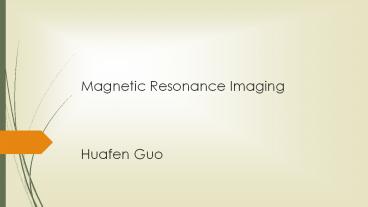Magnetic Resonance Imaging - PowerPoint PPT Presentation
Title:
Magnetic Resonance Imaging
Description:
Magnetic Resonance Imaging Huafen Guo Introduction Medical Imaging Part of Biomedical imaging Radiology X-ray radiography ultrasound endoscopy magnetic resonance ... – PowerPoint PPT presentation
Number of Views:338
Avg rating:3.0/5.0
Title: Magnetic Resonance Imaging
1
Magnetic Resonance Imaging
- Huafen Guo
2
Introduction
Medical Imaging
Radiology
Part of Biomedical imaging
endoscopy
etc.
ultrasound
X-ray radiography
magnetic resonance imaging
Etc.
- Neuroimaging
- neurological cancer
- Musculoskeletal
- joint disease
- and soft tissue tumors
- Functional MRI
- brain
3
Components
4
Procedure
- Three field involved
- Static magnetic field (very strong one)
- gradient field
- Radio-frequency (RF) field.
- MR signal protons spin around their own axes
5
Procedure
- Excitation it obtain information from the spins,
powerful radio transmitter to generate the
electromagnetic field to excite the spins. - Return to equilibrium RF frequency
transmitter-----switch off. - Spatial encoding MR signal from the proton
contain the information about where those protons
are positioned in the patient ------create the
image (three steps) - slice selection
- frequency encoding
- phase encoding.
6
Slice Selection
- Add magnetic gradient
- vertical slice the direction of gradients
altered to an anterior-posterior gradient.
7
Disadvantage
- exposure of RF field----implanted devices
- implant (level of safety)
- MR-Safe, completely nonmagnetic, non-electrically
conductive, and non-RF reactive. - MR-Conditional, may contain magnetic,
electrically conductive or RF-reactive. - MR-Unsafe contain magnetic electrically
conductive or RF-reactive. - projectile effect accidents
- acoustic noise---- ear protection
- Uncomfortable
- older scanner 40 minutes
- now20 minutes
8
Conclusion
- Better improvement in the future.
9
Question?
10
Reference
- M. Lakrimi1, A.M. Thomas, G. Hutton, M. Kruip, R.
Slade, P. Davis, A.J.Johnstone, M.J. Longfield,
H. Blakes, S. Calvert, M. Smith, C.A.
Marshall.(2011). The principles and evolution of
magnetic resonance imaging. Journalof Physics
Conference Series, Volume286,Number1.http//iopsci
ence.iop.org/article/10.1088/17426596/286/1/012016
jsessionid3BCB7EFDD1F401DB3AF8A4CB59C0B48B.c6.io
pscience.cld.iop.orgartAbst - Robert-Jan M. van Geuns, Piotr A. Wielopolski,
Hein G. de Bruin, Benno J.Rensing, Peter M.A. van
Ooijen, Marc Hulshoff,Matthijs Oudkerk, and Pim
J.de Feyter. (1999). Basic principles of magnetic
resonance imaging. Volume 42,Issue 2,Pages
149156. Retrievedfromhttp//www.sciencedirect.com
.uri.idm.oclc.org/science/article/pii/S00330620997
00149 - Domenico F. Sergio S. (2004). Biological effects
of exposure to magneticresonance imaging an
Overview.Vol.3,p.11-11Retrievedfromhttp//web.b.eb
scohost.com.uri.idm.oclc.org/ehost/pdfviewer/pdfvi
ewer?vid1sid77e1ac2c-6bd2-4c35-869ffebbeaa21608
40sessionmgr115hid129 - Wikipedia.(2015). Medical imaging. Retrieved
fromhttps//en.wikipedia.org/wiki/Medical_imaging - Wikipedia.(2015). Magnetic resonance imaging.
Retrieved from https//en.wikipedia.org/wiki/Magne
tic_resonance_imaging































